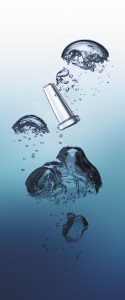Phase I
- examine the patient both extraorally and interoraly,
- examine the strength and stability of alveolar ridges,
- have X-rays made,
- explain the patient ZX-27 system and other suitable therapeutical solutions of his problems,
- examine X-rays,
- work out a therapeutical plan in cooperation with the patient
Phase II
- prepare hard dental tissues in compliance with the type of chosen pillar structure (metal, ceramics, special resin, etc.),
- prepare impression either using the technique of double impression or single-phase impression compound,
- impress always the whole dental arch and not only part of it!impress the antagonist mandibula or jaw, e.g. with alginate impression mass!
- make a wax bite impression bite into wax (or use other material),
- if there are no support zones preserved, record intermaxilla relations with bite stencils.
Phase III
- test the metal structure with freely applied glass abutments to find out the precision of both the metallic structure and glass abutments,
- Attention! Do not cement the abutments! Moisten them with water only. Moisten the structure as well.
- place abutments to their correct positions (the dental technician marks beforehand the labial and/or bucal side of the glass abutment with a leading groove),
- the moistened glass abutments will hold in the structure through their own adhesion,
- takto pripravenú konštrukciu vyskúšame klasickým spôsobom,while testing the structure see that the structure fits exactly on the alveolar arch mucosa when the structure is pressed on the patients own pillar teeth. When the structure is depressed at the points of glass abutments, the abutments will slightly animize the mucosa.
Phase IV
- test the abutments in the finished bridge in the same way as with the structure test in Phase III. without cementing.
- if the prepared supplement meets all the prosthetic criteria, start cementing the glass abutments into the ready bridge.
- take the bridge off the model so that the abutments remain at their own places on the model,
- apply mixed cement, the best is phosphate of denser consistency at the place of glass abutments in the bridge,
- replace the bridge on the model and glass abutments, which are on the model at their own places. This enables to find the correct position of glass abutments in the bridge. This position is fixed and finalized first by pressing the bridge together with the glass abutments to their own places within the oral cavity and then by pressing the bridge at the place of the patients own pillar teeth. Attention! Do not let the patient bite into the rolls!
- after cementation of the glass abutments, test the bridge in the mouth and if the prepared bridge meets all the prosthetic criteria (it is important to see that all glass abutments exactly match the mucosa of the alveolar arch and when the bridge is depressed at the points of glass abutments, the abutments slightly anemize the mucosa), start cementing the prosthesis.
Phase V
- check up after handing over of the prosthesis in regular intervals: after one week, three months, each half year; however, if there are problems, recommend the patient to visit his dentist immediately,
- it is normal if the patient feels a slight pressure on the gingiva around the abutments for about 3-5 days,
- instruct the patient on oral and dental hygiene and on prosthesis care: superfloss, interdental brushes, oral water…,
- have a check-up ortopantomogram made one year after the implantation of the prothesis.
The manufacturer shall not guarantee for the shortcomings created in the course of application of the supplement if the prescribed procedure are not observed and the specified materials are not used. The manufacturer shall guarantee for the quality of the material only if it is purchased his exclusive distributor and if ZX-27 glass abutments are made from prefabricates by certified dental technicians. The manufacturer shall not hold himself responsible for iatrogenous injuries with patients having different material for the abutment of fix dental prosthesis. Therefore, we highly recommend you to contact only certfied dental technicians.







